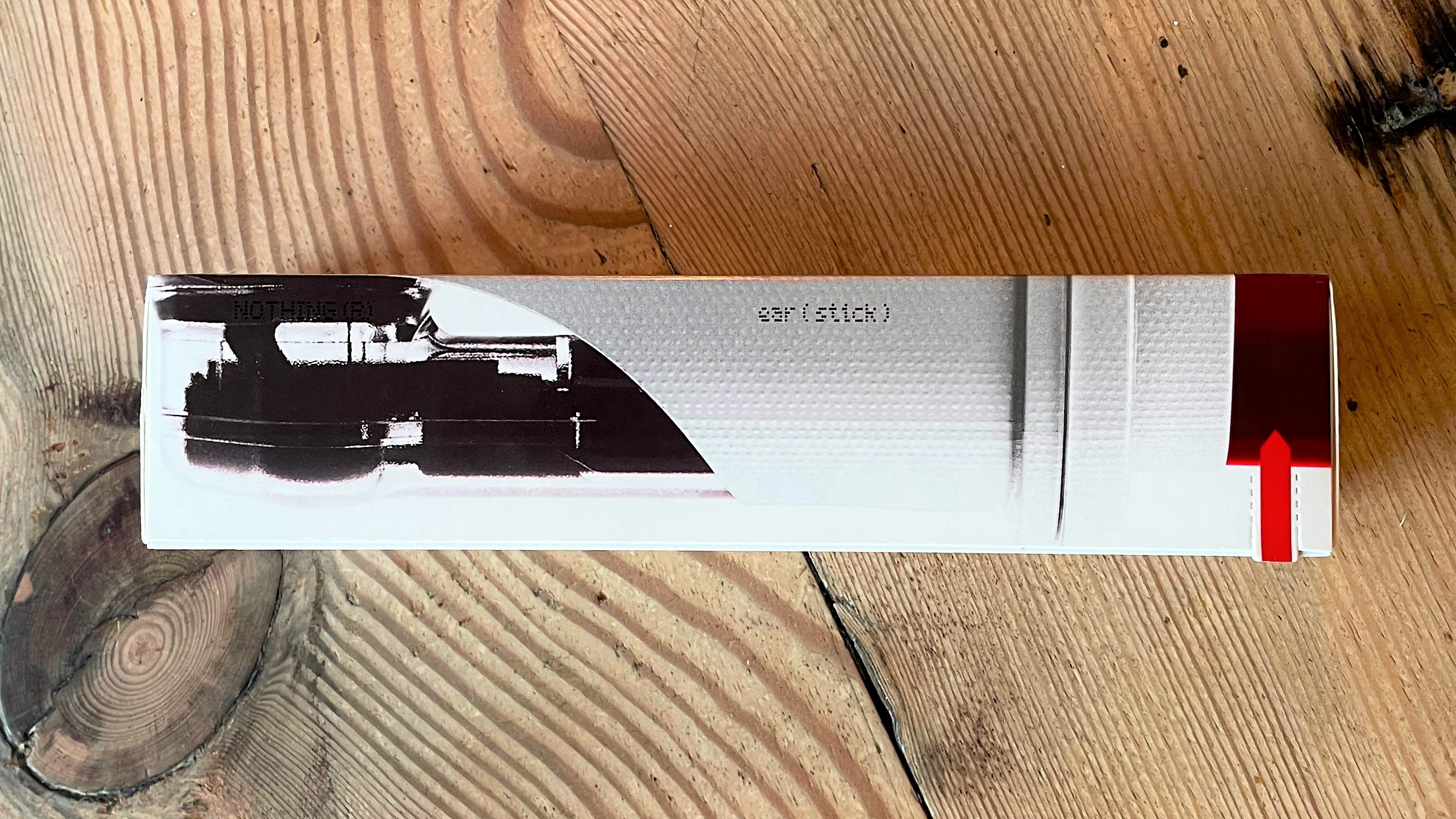Tom's Guide Verdict
The Nothing Ear (stick) hit the right note with fashion-conscious music fans and are a great addition for Phone (1) owners. We like the comfy fit and touch controls, but better overall performance can be found elsewhere at the same price.
Pros
- +
Half in-ear design
- +
Good comfort levels
- +
Effective touch controls
- +
Useful app
Cons
- -
Lacks bass
- -
No ANC
Why you can trust Tom's Guide
Price: $99 / $149 CAD / £99 / €119 / AU$179
Colors: White/transparent
Battery life (rated): 7 hours; 29 hours (charging case)
Connectivity: Bluetooth 5.2 (codec support: SBC and AAC)
Water resistance: Yes (IP54-rated)
Size: 1.17 x 0.74 x 0.72 inches (per bud); 3.4 x 1.17 x 1.17 inches (charging case)
Weight: 0.15 ounces (per bud); 1.63 ounces (charging case)
I've been following the teaser campaign for the Nothing Ear (stick) earbuds, and now, at last, I can bring you my full review of the wireless half in-ear 'buds that have been on my radar for a while.
These are the company's second set of earbuds, and they follow the Ear (1) ANC in-ear 'buds that launched last year. For anyone unfamiliar with the brand, Nothing is a young British company looking to shake up the relationship consumers currently have with tech through inspirational and functional product designs that offer a strong user experience at every level.
The aim, according to Nothing's CEO and co-founder Carl Pei, is to "make tech fun again" and a whole lot more accessible — from unpacking a product for the first time all the way through to the everyday usability experience.
I’ll be honest, I can appreciate where the company is coming from, and I’ve been looking forward for some time to getting stuck into this review to find out what all the fuss is about. Read on to find out my thoughts in this full Nothing Ear (stick) review.

Nothing Ear (stick) review: Price and availability
- Priced at $99 — considerably less than AirPods (3rd Gen)
- 10% discount for existing Nothing tech owners
The Nothing Ear (stick) earbuds are on sale now across the U.S., Canada, U.K., and Europe priced at $99 / CAD$149 / £99 / €119 / AU$179 through Nothing retailers, including the first Nothing store in Soho, London, and via the Nothing store website. Existing Nothing tech owners are eligible for a 10% discount.
I feel inclined to add a note of caution about the Ear (stick)'s $99 pricing though, as the Nothing Ear (1), the company's ANC earbuds that also started out at $99, recently increased in price by 50% to $149. In a statement, a Nothing spokesperson told me that the increase was in line with the global economic climate, increased operating costs, and further R&D costs incurred. Quite how long the Ear (stick) will be available at $99 is anyone's guess.

Nothing Ear (stick) review: Design and comfort
- Half in-ear design feels very comfortable
- Unique styling with strong build quality
To emphasize Nothing’s commitment to delivering fun and tactile products, the Ear (stick)'s cylindrical charging case looks very different to anything I’ve seen in the market before. Nothing says: “The case is inspired by lipstick silhouettes and features a unique, yet functional, twist opening.” The case feels remarkably tactile and I have to add that I'm particularly impressed with the packaging box the Ear (stick) ships in, which looks nothing like the standard carton packaging typically used to market a pair of $99 earbuds.
The Ear (stick) earbuds themselves are a half in-ear design that sit outside of the ear canal. They weigh less than the Ear (1) at 0.15 ounces per earbud, and I can honestly say that they feel super light in place in my ears. They feel remarkably secure too, although I wouldn't recommend using them as an exercise partner. Nevertheless, they are IP54-rated for dust, water and sweat resistance, which means they are very well protected should you feel inclined to do so.

Nothing Ear (stick) review: Controls
- Useful controls
- Reliable wear detection
The control scheme of the Nothing Ear (stick) uses physical controls to enable playback, skip tracks, adjust volume and call management. These can be customized in the app that's already integrated for Nothing Phone 1 owners, or downloadable for Android and iOS devices, which lets you swap out and assign functions to different input methods: single/double/triple tap or hold.
The control buttons give a good sense of tactile feedback to assure you that the commands have been made. The response time isn't the swiftest I've experienced but commands are carried out accurately.
Wear detection works both ways. Removing a single bud pauses playback, and placing both buds in your ears resumes playback immediately.
For this review, I've been using the Ear (stick) earbuds with an iPhone 12 Pro, and although Nothing doesn't mention voice activation or manual control to access AI bots, I was able to command Siri to deliver my music requests.

Nothing Ear (stick) review: Sound quality
- Bass levels can feel a bit lightweight
- Good vocal clarity
The 12.6mm dynamic drivers inside each Nothing Ear (stick) earbud produce a lively sound that's light and airy. It has plenty of detail, and the half in-ear design makes the soundstage feel pleasantly open with instruments and sounds placed in the sound space created just outside of the head. It's a pleasant enough listen, but there's something missing.
Of course, not everyone wants earbuds stuffed into their ear canal, but without the acoustic seal that's inherent in this style of earbud, you're likely to be missing out on low end frequencies. For me at least, the Ear (stick)s don't achieve the lower frequencies that give the music the bass energy that it really needs.

Despite the mention of smart software called Bass Lock Technology, which is said to measure the unique shape of the ear canal and the fit of the earbuds as they're being worn to optimize the sound output automatically, the Ear (stick) sounds too bass light for my tastes, even when playing bombastic bass tracks like "Dangerous" by Big Data. The natty customizable EQ goes some way to alleviating the bass shortfall, but even with it ramped up to max, these still sound a little thin and lacking in low end energy.
Midrange frequencies carry vocal elements well and voices always sound engaging, but there's just a bit too much brashness in the high frequencies to make these suitable for a longer listening sessions for my ears.

Nothing Ear (stick) review: Battery life
- Up to 7 hours of playback
- No wireless charging
Nothing rates battery life at 7 hours, and this seems to be pretty accurate in my testing so far. Keep in mind though that higher volume levels when you're trying to block out the general hubbub of background noise on your travels or in the office will reduce playback times.
The charging case holds up to 29 hours, depending how you use the buds. A 10-minute quick charge is said to generate around 2 hours of use. A USB-C charging cable is supplied. The case does not support wireless charging.

Nothing Ear (stick) review: Call quality and connectivity
I didn't encounter issues with voice and video calls, and conversations came through loud and clear. Nothing says that The Ear (stick) has improved call performance compared to the Ear (1), and that its Clear Voice Technology uses three high definition mics to work together with updated algorithms to filter out louder background noises to for wind-proof and crowd-proof calls. There's a low lag mode compatible with Phone 1.
The Ear (stick) operates on Bluetooth 5.2 with SBC and AAC audio codec support. Connectivity to my iPhone was stable throughout my time with the Ear (stick). Google Fast Pair and Microsoft Swift Pair are also on board for compatible devices.
Nothing Ear (stick) review: Verdict
Despite the half in-ear open design not creating quite the kind of sound balance I enjoy, the Nothing Ear (stick) still mange to do a lot of things right. There's plenty to appreciate here: great battery life, strong call quality, app integration and one of the most undeniably stylish pair of earbuds on the market right now. The Nothing Ear (stick) will win plenty of adoring fans, and at $99 I really can't argue with that.
More from Tom's Guide

After 2.5 years as Tom's Guide's audio editor, Lee has joined the passionate audio experts at audiograde.uk where he writes about luxury audio and Hi-Fi. As a former editor of the U.K.'s Hi-Fi Choice magazine, Lee is passionate about all kinds of audio tech and has been providing sound advice to enable consumers to make informed buying decisions since he joined Which? magazine as a product tester in the 1990s. Lee covers all things audio for Tom's Guide, including headphones, wireless speakers and soundbars and loves to connect and share the mindfulness benefits that listening to music in the very best quality can bring.

